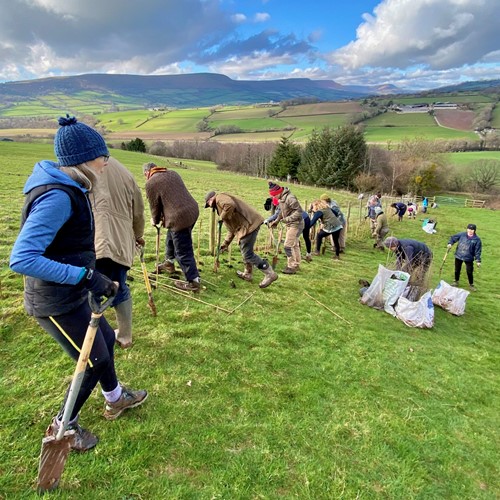Planting Diaries 3 - Home Hill

Planting at Home Hill was a great opportunity to be involved with a new smallholding and a young family at the start of their farming career. The owners had contacted Stump for advice on how to protect their recently purchased land from the strong northerly winds and they were also keen to increase wildlife habitat. Our Woodland Creation Officer, Kate Bevan, researched the history of the site and found that their land would have once part of an ancient semi natural woodland called Pen isar-plwyf wood prior to being cleared in the 1950s. Remnants of this wood, oak, ash, alder, hazel, and willow can still be seen along the boundary edges. This gave us an exciting link to the past in terms of choosing which species to plant and a chance to allow natural regeneration from a local seed source where possible.
The area around the site would have originally been small fields enclosed by hedgerows and woods. There were also several ponds linked by streams and a natural spring system for drinking water. The new owners hope to create an orchard in the upper field and to build a polytunnel and grow vegetables. After a varied career filmmaking and researching sustainability related issues, the family are hoping to build a low impact eco-home as part of a One Planet development. This is a unique Welsh Government scheme that allows people to live on their land and be self-sufficient.
After the initial discussion, it was decided that an interconnected series of hedgerows and shelterbelts were the best option to enclose the fields and join up the remaining boundary woodland. The advantages of this from the point of view of wildlife is that they have a continuous corridor for food and shelter. Species such as dormice prefer to spend their lives off the ground and in the understory of woodland so benefit from this type of planting. They also feed on the nuts and berries provided by trees like elder, hazel and hawthorn so these species were part of our planting plan. The owners were keen to be able to forage for fruit and nuts for their own use in the future, so edible species were to everyone’s advantage.

The two shelterbelts included in the design will be beneficial in several ways for humans and wildlife. Firstly, they will provide shelter from the prevailing winds and afford the orchard and vegetable garden much needed protection and thus better productivity. They will also provide shelter for any future livestock and for wild animals such as birds and small mammals. Shelterbelts have been shown to reduce erosion and the impact of flooding. Since the site is on a steep and wet slope, with any future home situated lower down the hill, these two things are of key importance. Furthermore, the fallen leaves enrich the soil and increase fertility as well as boosting mycorrhizal fungi and number of invertebrates such as worms and beetles.
On the plant day, we had a good number of volunteers from Stump, and we were well supported by friends of the owners. We split into several teams and two groups started on the hedgerows and one on the shelterbelts.

We were fortunate to have a rare sunny day in late February and were rewarded with some fantastic views of the Black Mountains. Volunteers were interested to learn more about the advantages of planting a three-row hedgerow, this creates a denser hedge much more quickly, and how to identify the different species including spindle and sweet chestnut. The owners shared more about their vision for a future community space on site where people can come to learn about sustainability and adaptation. An inspiring day for everyone and a wonderful opportunity to build a more positive future. We look forward to returning next year for further planting.

By Rachel Embury